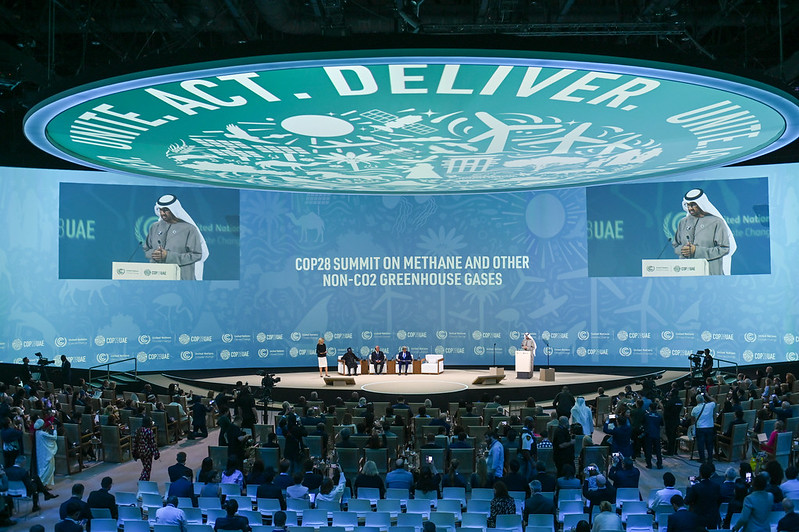The pledge and several initiatives under the new umbrella, Global Decarbonization Accelerator (GDA), so far are seen as a landmark deal on the mitigation front. But “fossil fuels phase-out” is still out of sight
Over the first few days of COP28, 116 countries have signed up on the new Global Renewables and Energy Efficiency Pledge, agreeing to triple worldwide installed renewable energy generation capacity and to double the global average annual rate of energy efficiency improvements to more than 4 per cent by 2030. The new installation could bring renewable energy capacity up to 11,000 gigawatts, according to COP28’s host, the UAE.
According to the UAE, 27 countries have also agreed to endorse a global certification standard and to recognize existing certification schemes, helping to unlock global trade in low-carbon hydrogen under its Hydrogen Declaration of Intent. The new commitments are among a series of new initiatives under the Global Decarbonization Accelerator (GDA) designed to speed up the energy transition and drastically reduce global emissions by the host.
According to the UAE, the GDA is focused on three key pillars: rapidly scaling the energy system of tomorrow; decarbonizing the energy system of today; and targeting methane and other non-CO2 greenhouse gases (GHGs). It claims that this is a comprehensive plan for system-wide change, addressing the demand and the supply of energy at the same time.
The GDA has been informed by the thinking of key stakeholders, including international organisations, governments and policymakers, NGOs, and CEOs from every industrial sector, the UAE cited.
“The world does not work without energy. Yet the world will break down if we do not fix energies we use today, mitigate their emissions at a gigaton scale, and rapidly transition to zero carbon alternatives,” said COP28 President, Dr. Sultan Al Jaber, who is also president of Adnoc, the UAE national oil company, which the Guardian reported as having boasted US $802 million in net profits last year or a 33% rise from 2021.
Under the GDA, 50 companies, representing over 40 per cent of global oil production have signed on to the Oil and Gas Decarbonization Charter (OGDC), committing to zero methane emissions and ending routine flaring by 2030, and to total net-zero operations by 2050 at the latest. Over 29 National Oil Companies (NOCs) have committed to the Charter_the largest ever number of NOCs to sign up for a decarbonization pledge, the UAE claims, adding that this charter is an important step towards the industry increasing actions aligned with the aims of the Paris Agreement. None of it mentioned the whole fossil fuels phase-out as heavily demanded.
Signatories to the Charter agree to target a number of key actions including:
- Investing in the energy system of the future including renewables, low-carbon fuels and negative emissions technologies.
- Increasing transparency, including enhancing measurement, monitoring, reporting and independent verification of GHG emissions and their performance and progress in reducing emissions.
- Increasing alignment with broader industry best practices to accelerate decarbonization of operations and aspire to implement current best practices by 2030 to collectively reduce emission intensity.
- Reducing energy poverty and providing secure and affordable energy to support the development of all economies.
The GDA also sees the launch of the Industrial Transition Accelerator (ITA), which will accelerate decarbonization across key heavy-emitting sectors and encourage policymakers, technical experts and financial backers to work hand-in-hand with industries to unlock investment and rapidly scale the implementation and delivery of emissions-reduction projects.
The third pillar of the GDA will address methane and other non-CO2 greenhouse gases through economy-wide methane-emission reduction. In support of this, more than US $1 billion will be mobilized for methane abatement projects, with additional information to be released at the COP28 Energy Thematic Day, according to the COP28’s host.
The GDA also covers the Global Cooling Pledge, which targets substantially reducing global cooling emissions by 68 per cent by 2050, the UAE added. Such emissions account for seven per cent of the global total, a figure expected to triple as more nations adopt air-conditioning. 52 countries so far have signed the Pledge.
According to a Summary of the series of High-Level Dialogues prepared by the UAE and the International Energy Agency (IEA) in the run-up to COP28, a call-to-action on accelerating the energy transition and keeping 1.5C in reach was made. The event was attended by ministers, decision-makers and chief executive officers (CEOs) from over 40 countries and 20 organizations. They discussed key elements of the energy transition including renewables, energy efficiency, financing, fossil fuel demand and supply, and decarbonization, according to the UAE.
“The Summary sets the tone for countries to decide an ambitious response to the Global Stocktake, setting us on a path to an energy system consistent with keeping 1.5C degrees within reach,” said Dr. Al Jaber.
As noted in the Summary, the dialogues showed that there is recognition that concrete, collective action is required from all countries and industries to deliver a clean energy transition whilst ensuring energy security and energy access fundamental for growth, particularly in developing countries.
According to the Summary, the participants of the dialogues participants broadly converged around the target of tripling global installed renewable energy capacity to 11,000 GW by 2030 and doubling annual energy efficiency improvements in the same timeframe.
“In parallel, fossil fuel demand and supply must phase-down this decade to keep 1.5C within reach,” the Summary noted their remarks, which call on the fossil fuel industry to “decarbonize existing operations whilst increasing investment in renewable and low-carbon alternatives” and to set and deliver on ambitious target to cut methane emissions by 2030.
There was a strong consensus that climate finance and clean investment will need to be significantly scaled up, with the IEA estimating US $4.5 trillion will be needed annually by the early 2030s, according to the Summary.
With around 760 million people around the world lacking access to electricity, and 2.3 billion lacking access to modern cooking facilities, the participants also stressed the importance of making the energy transition “just and orderly”, the Summary noted, and “Developed economies should move faster and support developing economies,” it added.
“By redefining the relationship between government, the biggest energy producers and heavy industry, we can align the supply and demand side of the equation to build the energy system of the future, while decarbonizing the system we have today. This has been one of the key priorities of my Presidency,” said Dr. Al Jaber.
Source: COP28 UAE
Indie • in-depth online news agency
to “bridge the gap” and “connect the dots” with critical and constructive minds on development and environmental policies in Thailand and the Mekong region; to deliver meaningful messages and create the big picture critical to public understanding and decision-making, thus truly being the public’s critical voice


